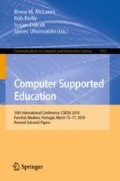Abstract
Classroom response systems are widely recognized as an effective way to engage and motivate students, improve knowledge retention, and provide formative feedback opportunities for both students and educators, and as such present an excellent opportunity to improve the student classroom experience. Unfortunately, there remain concerns in the pedagogical research community that the use of classroom response systems can distract, confuse, or intimidate students. The authors believe that these concerns can be mitigated by fully integrating classroom response system technologies into the classroom, such that the systems become an integral part of the lecture experience and not simply a intermittent supplementary activity. To fully integrate classroom response systems into a course, it is necessary for educators to unlock the full potential of classroom response systems. Over the past several years, the authors were able to achieve this full integration and gather data from almost 500 computer science students. The findings, presented in this paper, clearly indicate that students appreciate the activity and fully recognize its value as an enhancement to their learning experience, and do not, for the most part, consider these systems to be a source of distraction or confusion.
Access this chapter
Tax calculation will be finalised at checkout
Purchases are for personal use only
References
Reading, A.: Kawash, J., Collier, R.D.: On the use of classroom response systems as an integral part of the classroom. In: Proceedings of the 10th International Conference on Computer Supported Education, CSEDU 2018, 15–17 March 2018, Funchal, Madeira, Portugal, vol. 1, pp. 38–46 (2018)
Boscardin, C., Penuel, W.: Exploring benefits of audience-response systems on learning: a review of the literature. Acad. Psychiatry 36, 401–407 (2012)
Moss, K., Crowley, M.: Effective learning in science: the use of personal response systems with a wide range of audiences. Comput. Educ. 56, 36–43 (2011)
Kay, R.H., LeSage, A.: Examining the benefits and challenges of using audience response systems: a review of the literature. Comput. Educ. 53, 819–827 (2009)
Bruff, D.: Teaching with Classroom Response Systems: Creating Active Learning Environments. Jossey-Bass, San Francisco (2009)
Moredich, C., Moore, E.: Engaging students through the use of classroom response systems. Nurse Educ. 32, 113–116 (2007)
Blasco-Arcas, L., Buil, I., Hernandez-Ortega, B., Sese, F.J.: Using clickers in class. The role of interactivity, active collaborative learning and engagement in learning performance. Comput. Educ. 62, 102–110 (2013)
Webb, A., Carnaghan, C.: Investigating the effects of group response systems on student satisfaction, learning and engagement in accounting education. Issues Acc. Educ. 22, 391–409 (2006)
Porter, L., Zingaro, D., Lister, R.: Predicting student success using fine grain clicker data. In: Proceedings of the Tenth Annual Conference on International Computing Education Research, ICER 2014, pp. 51–58. ACM, New York (2014)
Liao, S.N., Zingaro, D., Laurenzano, M.A., Griswold, W.G., Porter, L.: Lightweight, early identification of at-risk CS1 students. In: Proceedings of the 2016 ACM Conference on International Computing Education Research, ICER 2016, pp. 123–131. ACM, New York (2016)
Porter, L., Simon, B.: Retaining nearly one-third more majors with a trio of instructional best practices in CS1. In: Proceeding of the 44th ACM Technical Symposium on Computer Science Education, SIGCSE 2013, 165–170. ACM, New York (2013)
Simon, B., Kinnunen, P., Porter, L., Zazkis, D.: Experience report: Cs1 for majors with media computation. In: Proceedings of the Fifteenth Annual Conference on Innovation and Technology in Computer Science Education, ITiCSE 2010, pp. 214–218. ACM, New York (2010)
Simon, B., Parris, J., Spacco, J.: How we teach impacts student learning: Peer instruction vs. lecture in CS0. In: Proceeding of the 44th ACM Technical Symposium on Computer Science Education, SIGCSE 2013, pp. 41–46. ACM, New York (2013)
Huss-Lederman, S.: The impact on student learning and satisfaction when a CS2 course became interactive (abstract only). In: Proceedings of the 47th ACM Technical Symposium on Computing Science Education, SIGCSE 2016, p. 687. ACM, New York (2016)
Collier, R.D., Kawash, J.: Improving student content retention using a classroom response system. In: CSEDU 2017 - Proceedings of the 9th International Conference on Computer Supported Education, Volume 1, 21–23 April 2017, Porto, Portugal, pp. 17–24 (2017)
Vinaja, R.: The use of lecture videos, ebooks, and clickers in computer courses. J. Comput. Sci. Coll. 30, 23–32 (2014)
Draper, S.W., Brown, I.M.: Increasing interactivity in lectures using an electronic voting system. J. Comput. Assist. Learn. 20, 81–94 (2004)
Author information
Authors and Affiliations
Corresponding author
Editor information
Editors and Affiliations
Rights and permissions
Copyright information
© 2019 Springer Nature Switzerland AG
About this paper
Cite this paper
Kawash, J., Collier, R. (2019). Improving Student Learning Experience by the Full Integration of Classroom Response Systems into Lectures. In: McLaren, B., Reilly, R., Zvacek, S., Uhomoibhi, J. (eds) Computer Supported Education. CSEDU 2018. Communications in Computer and Information Science, vol 1022. Springer, Cham. https://doi.org/10.1007/978-3-030-21151-6_3
Download citation
DOI: https://doi.org/10.1007/978-3-030-21151-6_3
Published:
Publisher Name: Springer, Cham
Print ISBN: 978-3-030-21150-9
Online ISBN: 978-3-030-21151-6
eBook Packages: Computer ScienceComputer Science (R0)

